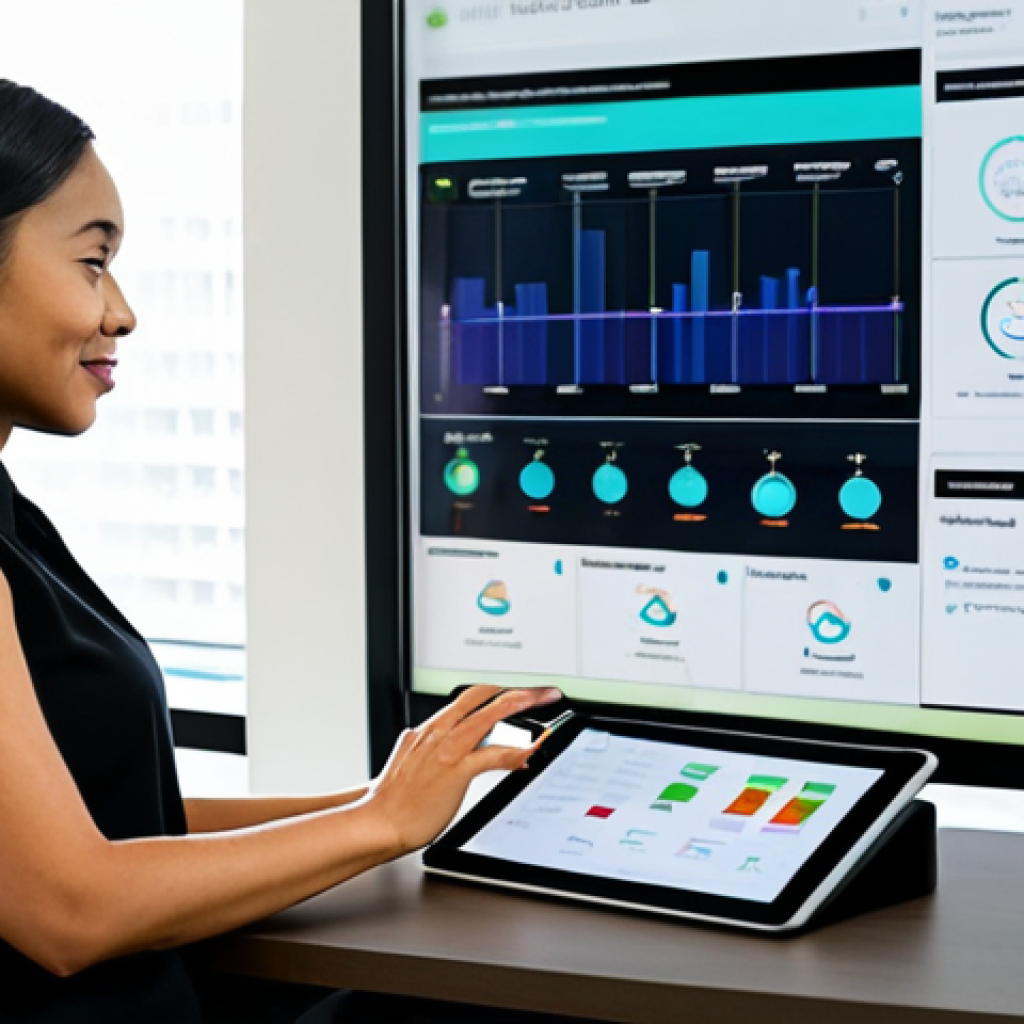Being a Wellness Coordinator in today’s fast-paced world feels like being an orchestra conductor, trying to harmonize countless elements for optimal well-being.
I remember when this role primarily revolved around gym memberships, but the landscape has utterly transformed. We’re now talking about mental resilience, financial literacy, and even digital detox – a truly holistic approach that demands sophisticated tools.
Gone are the days of simple spreadsheets; we need innovative solutions to genuinely impact lives. The right toolkit is no longer a luxury, but an absolute necessity to navigate this complexity.
Let’s find out precisely what’s shaping the future of wellness support. The rise of AI-driven personalized insights and hyper-targeted health apps has fundamentally shifted how we approach individual needs.
I’ve personally seen the struggle of integrating disparate data points, but cutting-edge platforms are now making it seamless, offering predictive analytics for proactive care.
From my perspective, the future of wellness coordination will heavily rely on these smart ecosystems, moving beyond reactive interventions to truly preventative, empowering strategies.
It’s an exciting, albeit challenging, time to be in this field, requiring both empathy and technological savvy to truly foster well-being in a world increasingly grappling with burnout and information overload.
Embracing the Hyper-Personalization Revolution

The shift from one-size-fits-all wellness programs to hyper-personalized experiences has been nothing short of a revelation for me. I remember those early days, meticulously trying to tailor generic health plans to individuals, often feeling like I was forcing square pegs into round holes.
It was exhausting and, frankly, ineffective. But today, the landscape is transformed, largely thanks to sophisticated AI platforms that can analyze an individual’s unique health data, preferences, and even their behavioral patterns to craft truly bespoke wellness journeys.
When I first started integrating these tools, I was skeptical; could an algorithm really understand the nuances of a person’s life, their stressors, their aspirations?
What I’ve found, however, is that these platforms, when used with a human touch, become incredibly powerful allies. They don’t replace the empathy and understanding of a coordinator, but rather augment our abilities, allowing us to reach more people with more precise, impactful interventions.
This isn’t just about suggesting a yoga class; it’s about understanding why someone might benefit from that class specifically, at a particular time, and how it aligns with their broader life goals.
It’s about creating a sense of being truly seen and understood, which fosters much deeper engagement and, ultimately, more sustainable change.
Predictive Analytics for Proactive Care
One of the most exciting developments I’ve witnessed is the emergence of predictive analytics within wellness tech. We used to be reactive, dealing with burnout and health issues *after* they manifested.
Now, with the right data inputs – from wearable tech to anonymized survey responses and even digital footprint analysis (always with utmost privacy in mind, of course) – we can identify potential risk factors before they escalate.
I’ve seen platforms flag early signs of stress accumulation, sleep deprivation trends, or even a dip in physical activity that might indicate an impending slump.
This allows us, as wellness coordinators, to intervene proactively, offering targeted support, resources, or a simple check-in call before a small issue becomes a major crisis.
It feels like having a highly intelligent early warning system, giving us the chance to truly prevent rather than just treat. This isn’t about scaring people; it’s about empowering them with insights and timely support, shifting the paradigm from ‘sick care’ to ‘well care.’ My own experience with these systems has shown me that when individuals feel supported *before* they hit a wall, their trust in the program, and in me, skyrockets, leading to far better long-term outcomes.
AI-Powered Personalized Journeys
Beyond mere prediction, these intelligent systems are now designing entire personalized wellness journeys. Imagine a platform that, knowing your sleep patterns, stress levels, and even your preferred time of day for activity, suggests not just a generic meditation app, but a specific 10-minute guided breathwork session tailored to your current energy levels, followed by a suggestion for a specific healthy snack that aligns with your dietary needs.
That’s the reality now. I remember a participant who was struggling with consistent exercise. Generic advice wasn’t cutting it.
But when her personalized plan started suggesting short, high-intensity workouts that fit perfectly into her erratic schedule, coupled with recovery tips based on her heart rate variability data, she finally found her rhythm.
It was a game-changer. These aren’t rigid programs; they’re adaptive, evolving with the individual’s progress and changing circumstances. My role has transformed from dictating programs to curating and facilitating these intelligent journeys, adding the human element of encouragement, coaching, and accountability that algorithms, however smart, can’t fully replicate.
It’s a true synergy.
Leveraging Wearable Technology and Connected Ecosystems
In my career as a Wellness Coordinator, few innovations have had as profound an impact as wearable technology. When smartwatches first emerged, they felt like a novelty, a cool gadget for tech enthusiasts.
But now, they’re indispensable tools, providing a constant, unobtrusive stream of data that offers unparalleled insights into an individual’s daily well-being.
From step counts to heart rate variability, sleep stages, and even stress metrics, these devices paint a detailed picture of a person’s physiological state.
The real magic, however, isn’t just in the data itself, but in how it integrates with broader wellness ecosystems. I’ve wrestled with isolated data points for years, trying to stitch together a coherent narrative from spreadsheets and self-reported logs.
Now, platforms are emerging that seamlessly pull data from multiple devices and apps, creating a holistic dashboard that reveals trends and connections I could only dream of before.
This integration allows me to see, for instance, how a period of poor sleep might correlate with increased stress markers, or how consistent movement positively impacts mood.
It’s like having a personalized health laboratory on each individual’s wrist, helping us identify patterns and make data-driven decisions that genuinely move the needle on health outcomes.
The challenge, of course, is ensuring privacy and educating users on how to interpret this data without becoming overly anxious or obsessive, a balancing act that requires both technological prowess and a deep understanding of human psychology.
Real-Time Biometric Feedback and Coaching
The immediate feedback loop provided by wearables is a game-changer for behavioral change. I’ve observed firsthand how seeing one’s sleep score plummet after a late-night screen session, or witnessing a higher recovery score after a structured rest day, can provide powerful motivation.
It’s no longer abstract advice; it’s concrete, personal data. Some advanced wearables even offer real-time coaching prompts, like a gentle buzz to remind you to stand up and stretch, or a suggestion for a mindful breathing exercise when a spike in stress is detected.
For me, this is where the “experience” element of E-E-A-T truly comes alive. I’ve personally used these features to manage my own energy levels during busy periods, and the self-awareness they foster is invaluable.
This isn’t about micromanaging; it’s about empowering individuals to understand their own bodies and minds better, giving them actionable insights right when they need them.
It transforms vague intentions into tangible actions, fostering a sense of agency that is crucial for sustained well-being.
Integrating Data for Holistic Insights
The real power of modern wellness tech isn’t just in individual devices, but in their ability to communicate. I’ve spent countless hours in the past trying to manually input data from a fitness tracker into a separate nutrition app, then transfer that to a third platform for mental health journaling.
It was clunky, time-consuming, and prone to errors. Today, truly integrated platforms serve as a central hub, pulling in data from wearables, smart scales, continuous glucose monitors, and even digital mental health apps.
This unified view allows for holistic insights that were previously impossible. For example, I can now see how a client’s improved dietary habits correlate with better sleep scores and reduced anxiety levels, or how increased social engagement impacts their overall mood and energy.
This comprehensive data picture allows us to move beyond siloed interventions and build truly interconnected wellness strategies that address the whole person.
This kind of integration means I spend less time on administrative tasks and more time on what truly matters: direct coaching, support, and strategic program design.
Enhancing Mental and Emotional Resilience Digitally
The past few years have undeniably shone a harsh spotlight on the critical importance of mental and emotional well-being. As a Wellness Coordinator, I’ve seen a dramatic increase in the demand for robust mental health support, far beyond just stress management workshops.
The traditional model simply couldn’t keep up with the scale of need. Thankfully, digital solutions have stepped in to fill many gaps, offering accessible, scalable, and often highly personalized avenues for mental and emotional support.
This isn’t about replacing human therapy, but rather complementing it, making foundational tools for resilience building available to everyone, anytime, anywhere.
I’ve personally experimented with countless apps and platforms, sifting through the noise to find those that genuinely offer evidence-based techniques delivered in an engaging, empathetic way.
The goal is to empower individuals with self-management skills, helping them navigate life’s inevitable ups and downs with greater fortitude. It’s about building a proactive mental health toolkit, not just reacting when a crisis hits.
CBT and DBT Integration through Digital Platforms
One area where digital tools have truly excelled is in the delivery of Cognitive Behavioral Therapy (CBT) and Dialectical Behavior Therapy (DBT) principles.
For many, accessing a qualified therapist for these specialized approaches can be cost-prohibitive or geographically challenging. Digital platforms, however, are now offering structured modules, interactive exercises, and guided practices that make these powerful therapeutic techniques widely available.
I’ve personally guided participants through these digital programs, and the results have been remarkable. Seeing individuals learn to identify cognitive distortions, practice emotional regulation skills, or develop distress tolerance strategies through an app, and then apply those skills in their real lives, is incredibly rewarding.
It provides a consistent, private space for self-reflection and skill acquisition, often at a pace that suits the individual. My experience has shown that combining these digital resources with regular check-ins or group discussions amplifies their impact, creating a hybrid approach that leverages both technology’s reach and human connection.
Cultivating Resilience in a Remote World
The shift to remote and hybrid work models has introduced new challenges for maintaining mental resilience. The blurring of work-life boundaries, increased isolation, and constant digital connectivity can take a toll.
Digital wellness tools have become vital in addressing these specific pressures. I’ve seen success with platforms that offer guided “digital detox” exercises, virtual reality environments for relaxation, or even simple prompts for mindful breaks throughout the workday.
Building resilience in this new normal isn’t just about managing stress; it’s about fostering healthy digital habits, maintaining social connections despite physical distance, and developing coping mechanisms for the unique demands of remote living.
My own journey as a coordinator has involved discovering and implementing solutions that help individuals create boundaries, find moments of calm, and cultivate a sense of connection even when working from their home office.
These tools act as a vital support system, helping prevent burnout and ensuring that mental well-being remains a priority, no matter where someone is working from.
Financial Wellness: The Unsung Pillar of Holistic Health
It might seem counterintuitive to talk about financial well-being in the same breath as physical fitness or mental health, but in my years as a Wellness Coordinator, I’ve come to understand that financial stress is one of the most pervasive and debilitating factors impacting overall well-being.
It’s an issue that often lurks beneath the surface, yet its ripple effects touch every aspect of a person’s life – from sleep quality and anxiety levels to relationship strain and even chronic health conditions.
Addressing financial health isn’t just about offering budgeting tips; it’s about empowering individuals with the knowledge, tools, and confidence to manage their money in a way that reduces stress and fosters a sense of security.
I’ve personally seen how a targeted financial wellness program can significantly lower stress levels, improve focus at work, and even boost participation in other wellness initiatives, simply because people feel less overwhelmed and more in control of their lives.
It’s an often-overlooked, yet absolutely crucial, component of a truly holistic wellness strategy. We’re moving beyond mere “financial literacy” to “financial well-being” – a much broader, more empathetic approach.
Bridging Financial Literacy with Emotional Well-being
The emotional toll of financial insecurity is immense. Worries about debt, unexpected expenses, or simply making ends meet can lead to chronic stress, anxiety, and even depression.
I’ve had countless conversations where participants initially sought help for sleep issues or stress, only to discover that the root cause was deeply intertwined with their financial situation.
Modern financial wellness platforms are now recognizing this connection, integrating not just practical tools but also emotional support components. They might offer modules on managing financial anxiety, coping with debt-related stress, or building a positive money mindset.
For me, the most impactful programs are those that frame financial health not as a series of rigid rules, but as a journey of empowerment and control, directly linking responsible financial habits to improved emotional stability.
It’s about providing a safe space to discuss what can be a very vulnerable topic, and then equipping individuals with both the practical skills and the emotional resilience to navigate their financial landscape effectively.
Tools for Budgeting, Planning, and Stress Reduction
The digital tools available for financial wellness have become incredibly sophisticated, moving far beyond basic spreadsheets. We’re now seeing platforms that offer intuitive budgeting interfaces, automated savings features, debt management trackers, and even personalized investment guidance (within ethical boundaries, of course).
My experience has shown that the key is simplicity and accessibility. If a tool is too complex or overwhelming, people won’t use it. The best solutions seamlessly integrate with banking apps, provide clear visual summaries of spending, and offer nudges towards healthier financial habits without being preachy.
I’ve particularly valued tools that help users visualize their financial future, whether it’s saving for a down payment or planning for retirement. This forward-looking perspective can be incredibly motivating and stress-reducing.
When individuals feel a sense of control over their money, a huge burden is lifted, allowing them to engage more fully with other aspects of their well-being.
Fostering Community and Connection in a Digital Age
One of the biggest lessons I’ve learned as a Wellness Coordinator, especially in recent years, is that true well-being is not just an individual pursuit; it’s deeply rooted in connection and community.
Loneliness and social isolation are becoming recognized as significant public health concerns, impacting both mental and physical health. While technology can sometimes contribute to isolation if misused, it also offers incredible opportunities to build and foster vibrant communities, especially when geographical proximity isn’t possible.
I remember feeling a bit daunted by the idea of creating genuine connection in a virtual space, but I’ve been pleasantly surprised by the innovation in this area.
From virtual challenges to interest-based groups, the right digital platforms can create a sense of belonging and shared purpose that is incredibly powerful.
My role has evolved to become more of a community architect, leveraging these tools to bridge gaps, spark conversations, and facilitate interactions that make individuals feel less alone and more supported on their wellness journeys.
It’s about creating spaces where people feel comfortable sharing their struggles and celebrating their successes, fostering a supportive ecosystem that extends beyond scheduled program activities.
Virtual Wellness Hubs and Engagement Platforms
The modern wellness coordinator needs a robust digital hub that serves as the central nervous system for their programs. This isn’t just a place to post announcements; it’s an interactive space where participants can connect with each other, access resources, track their progress, and engage with challenges.
I’ve personally seen the profound impact of well-designed platforms that encourage peer-to-peer support. Imagine a forum where employees share healthy recipes, or a group chat where participants motivate each other to hit their daily step goals.
These platforms can host virtual fitness classes, mindfulness sessions, and even informal coffee breaks, replicating the serendipitous connections that often happen in physical workplaces.
The best ones are intuitive, gamified, and allow for personalized content delivery, ensuring that each participant finds relevance. They become the digital water cooler where wellness is discussed, shared, and celebrated, reinforcing positive behaviors through collective encouragement.
| Wellness Area | Traditional Approach | Modern Digital Tool Integration |
|---|---|---|
| Physical Activity | Gym memberships, infrequent health fairs | Wearable device syncing, AI-guided workouts, virtual fitness classes, gamified challenges |
| Mental Well-being | EAP brochures, occasional workshops | Personalized CBT/DBT apps, mindfulness & meditation platforms, virtual therapy access, resilience-building modules |
| Nutrition | Generic diet plans, cooking demos | AI-driven meal planning, smart food journaling, personalized recipe suggestions, nutritional supplement tracking |
| Financial Health | One-off seminars, basic budgeting sheets | Interactive budgeting apps, debt management tools, financial coaching platforms, retirement planning simulations |
| Community & Engagement | Company picnics, physical bulletin boards | Dedicated wellness portals, virtual group challenges, peer support forums, interest-based social groups |
Gamification and Incentive Structures
Let’s be honest, motivation can sometimes wane, especially when trying to build new habits. This is where gamification and well-designed incentive structures come into play within digital wellness platforms.
I’ve found that incorporating elements like points, badges, leaderboards, and team-based challenges can dramatically boost engagement. It transforms what might feel like a chore into a fun, competitive, and social activity.
When I first introduced a company-wide steps challenge using a platform that visually tracked team progress, the energy was palpable. People who had never considered walking for exercise were suddenly clocking miles, driven by friendly competition and the desire to contribute to their team’s success.
The incentives don’t always have to be monetary; sometimes, simply recognizing effort, celebrating milestones, or providing exclusive access to premium content is enough.
It’s about tapping into our innate desire for achievement and recognition, making the wellness journey feel less like an obligation and more like an exciting adventure.
My personal takeaway is that a little bit of fun and competition goes a long way in sustaining long-term engagement.
The Data Revolution: Measuring Impact and ROI
For years, one of the most persistent challenges in wellness coordination has been demonstrating tangible results. We knew our programs were making a difference, felt it in the anecdotal feedback and the improved morale, but proving it with hard data was often like trying to catch smoke.
This made it difficult to secure ongoing funding, justify resources, and continuously improve our offerings. However, the proliferation of digital wellness tools has ushered in a new era of data-driven insights.
We now have the capability to track engagement, measure behavioral changes, and even correlate wellness program participation with broader organizational metrics like absenteeism, healthcare claims, and productivity.
This isn’t just about showing that people *used* the tools; it’s about proving that those tools are contributing to a healthier, more engaged, and ultimately more productive population.
My experience has been that moving from subjective observations to objective data points has fundamentally changed the conversation with stakeholders, transforming wellness from a ‘nice-to-have’ perk into a strategic business imperative.
It allows us to be precise, to identify what’s working well, what needs adjustment, and where resources can be best allocated for maximum impact.
Aggregating Disparate Data Sources
The challenge, as I mentioned earlier, was often the fragmentation of data. Information lived in different apps, spreadsheets, and HR systems, making a unified view nearly impossible.
Modern wellness platforms, however, are designed to be powerful aggregators. They pull in data from wearables, mental health apps, financial wellness tools, EAP utilization reports, and even company health claims (always anonymized and aggregated, of course, to protect individual privacy).
This creates a comprehensive dashboard that allows me to see trends at a population level. For example, I can analyze how participation in a stress reduction program correlates with a decrease in reported anxiety levels across the organization, or how consistent engagement with a physical activity challenge impacts overall energy levels.
This ability to cross-reference and analyze diverse data sets is invaluable. It helps me identify patterns that would otherwise remain hidden, allowing for more targeted interventions and a deeper understanding of the overall health landscape of the population I serve.
Demonstrating Program Effectiveness to Stakeholders
Ultimately, the ability to clearly articulate the return on investment (ROI) of wellness programs is crucial for their long-term success. With robust data aggregation and analytics, wellness coordinators can now present compelling cases to leadership.
Instead of saying, “I think our new mental health app is helping,” I can now say, “Engagement with the mental health platform has increased by 30% in Q2, correlating with a 15% reduction in self-reported stress levels and a noticeable decrease in EAP utilization for anxiety-related issues.” This kind of data-backed narrative resonates strongly with executives.
I’ve personally seen how presenting clear metrics on participation rates, engagement scores, health improvements, and even proxy metrics for productivity or reduced absenteeism can transform wellness from a cost center into a strategic investment.
It empowers us to advocate for more resources, expand successful programs, and continuously refine our strategies based on concrete evidence, ensuring that our efforts are always aligned with the needs of the people we serve and the goals of the organization.
Future-Proofing Your Wellness Strategy: Adaptability is Key
The world of wellness is constantly evolving, driven by technological advancements, emerging health trends, and shifting societal needs. What was considered cutting-edge just a few years ago might already be mainstream or even outdated today.
As a Wellness Coordinator, I’ve learned that complacency is the enemy of progress. To truly future-proof our strategies and remain effective, we must embrace a mindset of continuous learning, experimentation, and adaptability.
This isn’t just about adopting new tools, but about understanding the underlying human needs they address and being prepared to pivot when new challenges or opportunities arise.
My personal journey in this field has been a testament to this constant evolution – from focusing purely on physical health to embracing mental, financial, and social well-being, and now integrating AI and data science into every facet of our work.
The most successful wellness initiatives are those that are agile, responsive, and always looking ahead, anticipating the next wave of innovation to better serve individuals and organizations.
Adaptability and Continuous Learning
The rapid pace of innovation in wellness tech means that what works today might be surpassed tomorrow. I’ve built a personal habit of dedicating time each week to exploring new platforms, reading industry reports, and connecting with peers to understand emerging best practices.
It’s not just about finding the next shiny object, but critically evaluating whether a new tool or approach genuinely addresses a need, aligns with our values, and integrates seamlessly into our existing ecosystem.
Adaptability also means being willing to let go of methods that no longer serve their purpose, even if they were once successful. It’s a continuous cycle of assessment, implementation, and refinement.
My experience has taught me that the willingness to experiment, even if some experiments don’t pan out, is essential for staying at the forefront of wellness support and ensuring that our programs remain relevant and impactful in a rapidly changing world.
Embracing the Human-Tech Synergy
Despite all the incredible technological advancements, one truth remains paramount: wellness is fundamentally human. AI, wearables, and digital platforms are powerful tools, but they are not replacements for empathy, connection, and genuine human support.
The future of wellness coordination lies in a robust human-tech synergy. My role has shifted from being the sole provider of wellness knowledge to becoming a curator of intelligent tools, a data interpreter, and, most importantly, a compassionate coach and connector.
The technology handles the data, the personalization, and the scalability, freeing me up to focus on the truly human elements: active listening, motivational interviewing, building rapport, and fostering community.
It’s about leveraging technology to amplify our human capacity for care and support, creating a more impactful, far-reaching, and profoundly human wellness experience.
This blend of cutting-edge tech with heartfelt human connection is, in my view, the most exciting and effective path forward for any modern Wellness Coordinator.
Concluding Thoughts
As we navigate an increasingly complex world, the role of a Wellness Coordinator has never been more vital, and the tools at our disposal are evolving at an astonishing pace. What truly excites me about this journey is the fusion of cutting-edge technology with the enduring power of human connection. We’re moving beyond reactive measures, empowering individuals with proactive insights and personalized support that was once unimaginable. It’s about building a holistic ecosystem where every aspect of well-being is nurtured, fostering resilience and joy in an ever-changing landscape. For me, it’s a profoundly rewarding path, seeing lives genuinely transformed through this dynamic synergy.
Useful Information
1. Personalized Wellness Plans: Embrace platforms that analyze your unique data (from wearables, surveys, etc.) to offer tailored recommendations for exercise, nutrition, and mental well-being, moving beyond generic advice.
2. Integrated Data for Holistic Views: Seek out wellness tools that connect with each other. A unified dashboard showing how your sleep, activity, and diet interrelate provides deeper insights than isolated apps.
3. Digital Mental Health Support: Explore apps and online resources offering CBT/DBT principles, mindfulness exercises, and stress management techniques. They’re excellent complements to traditional therapy, providing accessible self-care tools.
4. Financial Well-being is Key: Don’t overlook the impact of financial stress. Utilize budgeting apps, debt management tools, and platforms that link financial literacy with emotional support to build a more secure foundation.
5. Community and Gamification: Leverage digital platforms that foster connection through virtual challenges, peer support groups, and gamified incentives. A little friendly competition and shared goals can significantly boost engagement and sustained motivation.
Key Takeaways
Modern wellness strategies thrive on hyper-personalization, driven by AI and data analytics to offer proactive, tailored care. Wearable technology provides invaluable real-time insights, while digital platforms extend accessible support for mental and emotional resilience through evidence-based practices. Integrating financial wellness acknowledges its profound impact on overall health, and fostering digital communities through gamification boosts engagement. Crucially, the future lies in a human-tech synergy, where technology amplifies human compassion and expertise, ensuring measurable impact and continuous adaptability in an evolving wellness landscape.
Frequently Asked Questions (FAQ) 📖
Q: You mentioned the role has utterly transformed from just gym memberships. What’s the biggest shift you’ve personally witnessed, and what drove that change?
A: Oh, the biggest shift, hands down, has been the move from a purely physical focus to a truly holistic one. I remember when my biggest concern was negotiating a better corporate rate at the local gym, maybe getting a few more people to show up for a lunchtime yoga class.
But what I’ve seen over the last five to ten years, especially post-pandemic, is this intense realization that well-being isn’t just about your body; it’s about your mind, your finances, even your digital habits.
People are grappling with burnout, information overload, and genuine anxiety about their economic future. As a coordinator, I’ve watched as companies have started seeing that ignoring these aspects leads to real problems – disengaged employees, high turnover, plummeting productivity.
It’s no longer just a ‘nice-to-have’; it’s a critical business imperative. We had to adapt, quickly, because the needs of our people just exploded beyond the traditional physical realm.
Q: You highlighted the rise of
A: I-driven personalized insights and hyper-targeted health apps. How do these sophisticated tools tangibly impact your day-to-day work, and what’s the most surprising benefit you’ve seen from them?
A2: Honestly, these tools are a game-changer. In the old days, I’d be drowning in spreadsheets trying to piece together a picture of who needed what support.
It was like trying to predict the weather by looking at individual raindrops. Now, with AI platforms, it’s like having a super-smart assistant that connects all those disparate data points – anonymized, of course – and actually tells me what might happen.
For instance, I’ve seen predictive analytics flag groups at risk of burnout before it becomes a crisis, based on workload patterns and engagement metrics.
That’s not just reactive; that’s proactively putting resources in place, like launching a stress-management workshop for a specific department, instead of waiting for people to hit a wall.
The most surprising benefit? The sheer efficiency. It frees me up from manual data wrangling to actually connect with people, to be the empathetic human behind the tech, which is what truly matters in this role.
Q: Being a Wellness Coordinator sounds incredibly demanding, like conducting an orchestra. What’s the most significant challenge you face in orchestrating well-being today, and what personal qualities do you believe are absolutely essential to succeed in this complex environment?
A: The biggest challenge, without a doubt, is navigating the sheer complexity and constant evolution. It feels like I’m not just conducting an orchestra, but one that’s constantly adding new instruments and sheet music while we’re playing!
On one hand, you have the rapid pace of technological change – staying on top of the best apps, understanding data privacy, leveraging AI. On the other, you’re dealing with deeply human issues: stress, grief, financial insecurity, mental health struggles.
The tightrope walk is maintaining that genuine human connection and empathy while also being technologically savvy enough to utilize the tools that actually make a difference.
For me, essential qualities are an insatiable curiosity – always learning, always adapting – combined with a deeply empathetic heart. You need to be able to listen without judgment, understand the individual struggles, and then translate that into scalable, tech-driven solutions.
It’s a demanding balance, but seeing someone genuinely thrive because of a program you helped implement? That makes every complex note worth it.
📚 References
Wikipedia Encyclopedia
구글 검색 결과
구글 검색 결과
구글 검색 결과
구글 검색 결과
구글 검색 결과






